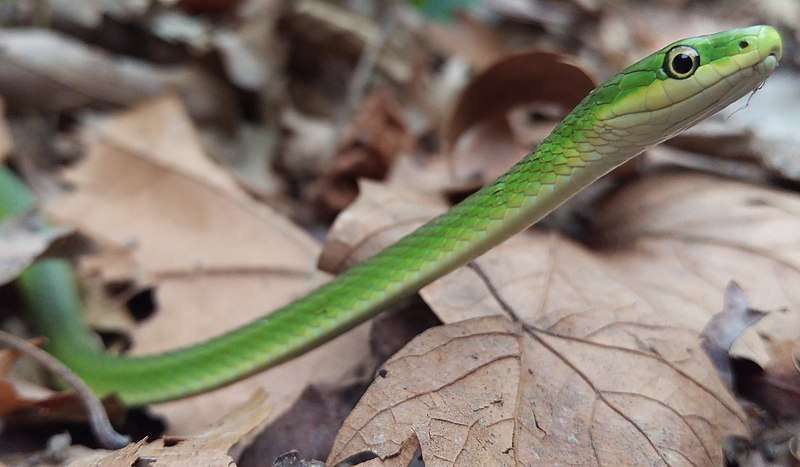
Description:
Scientific name: Opheodrys aestivus
Life span: Up to 8 years
The rough green snake, also known as Opheodrys aestivus, is a non-venomous colubrid found in North America. While these names are occasionally used to refer to it, they are more frequently used to refer to the smooth green snake (Opheodrys vernalis)
Although they are rather numerous in their habitat, the rough green snake (Opheodrys aestivus) is difficult to spot in the wild due to its superb camouflage in green vegetation and brilliant green upper body. It has 17 rows of keeled dorsal scales that are positioned at mid-body.

Native Region/Habitat
Rough green snakes are found all over the Southern United States, from Florida to Indiana’s shore, coastal Maine, and Central Texas in the north. The Piedmont and Atlantic coastal plains are frequent locations for them. Together with the state of Tamaulipas and eastern Nuevo León, these snakes can also be found in northeastern Mexico. They frequently live close to water in damp meadows, overgrown pastures, tallgrass prairie, thickets, vines, bushes, and forests.
Behavior:
Strong climbers in low vegetation, rough green snakes are very arboreal and capable swimmers. They can also frequently be found on the ground, though. They are mostly nocturnal and live alone, unlike many snakes. They curl up among shrubs, vine tangles, or dense vegetation at night to sleep. Rough green snakes hibernate in the chilly winter months, usually from December to February. These are calm animals that frequently allow humans to approach them up close. Seldom do they bite. Even when bites do occur, they are venom-free and safe. Rough green snakes, which rely on their green hue for concealment, prefer to freeze when threatened in an effort to avoid being seen.
Care As a pet/In captivity:
Habitat: Provide an adult rough green snake a habitat that is the right size and form to facilitate its typical activities. The snake should be able to stretch out in the habitats (at least a 20-gallon tank for a juvenile and a 30-gallon tank for a single adult). Moreover, habitats must be high enough for snakes to climb (at least half the length of the snake). In ideal circumstances, they grow to adult size in 2 to 3 years. Increase the size of their environment as your snake develops.
Temperature: Snakes are ectothermic reptiles, which implies that the outside temperature controls how hot or cold they are inside. To help them control their body temperature, their habitat should contain a temperature gradient (85 to 90°F in the warm/basking zone and 75 to 80°F in the cool zone/nighttime).
Heat can be produced via a heat bulb, a ceramic heat bulb, or an under-tank heating pad.
To regulate temperatures, thermostats must be connected to heat sources. The usage of thermostats is necessary because heating pads might become too hot and cause burns through the tank floor if not properly managed.
Humidity: A water dish big enough for the snake to soak in should be included in the habitat to regulate humidity levels, keep them hydrated, and facilitate shedding.
Sphagnum moss that is damp can also enhance humidity; however, it needs to be replaced periodically to prevent the spread of mold.
A humidity gauge should be used to monitor the humidity level, which should be kept between 55 and 65%.
Diet: Given that rough green snakes are one of the few snakes that consume insects, a well-balanced rough green snake diet should include gut-loaded (recently fed) crickets, moths, waxworms, caterpillars, mealworms, soft-bodied beetles or spiders, fly larvae or superworms.
Mealworms and crickets should only be provided on rare occasions because of their hard exoskeletons, which might cause gastrointestinal obstruction if consumed too regularly.
Table





